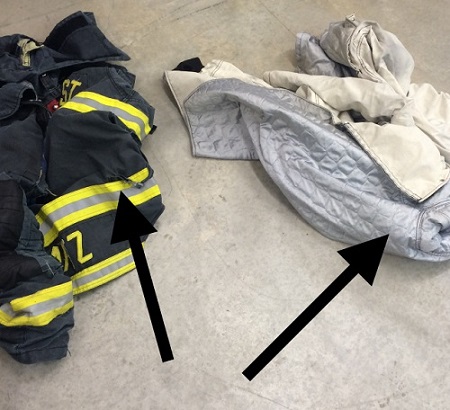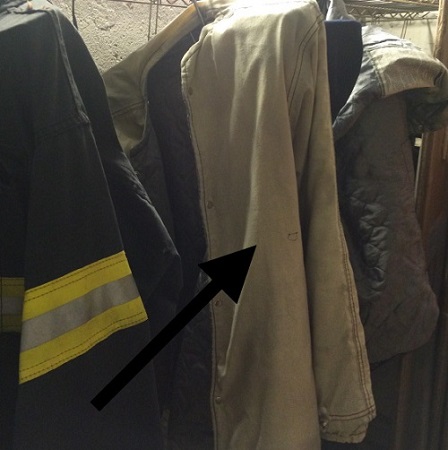Throw Back to Basics Training Drill | By Brian Zaitz
Today’s fire gear is designed to protect firefighters from the harshest conditions, providing excellent thermal protection and abrasion resistance. Turnout gear is the one tool we use on almost every alarm, and it is the one tool designed to protect the firefighter.
Turnout gear works by absorbing heat energy. The gear is made of several layers such as the outer shell, which provides abrasion protection and some thermal protection along with protection to the inner layers.
The next layer is the moisture barrier, which provides protection from moisture absorption while allowing the moisture to escape, allowing heat to be released from the firefighter’s body.

The final layer is the thermal barrier. This is traditionally a soft or slick material that provides comfort to the firefighter as well as thermal protection.
Between each layer is air space. Air is an excellent insulator and a great dissipater of heat energy. Many times, firefighters notice burns or injuries around their shoulders; this is from the self-contained breathing apparatus straps “crushing” this air space, providing less protection to that area than other areas of the gear.
RELATED FIREFIGHTER TRAINING
- Reed on Maintaining Turnout Gear
- Introduction to the Fire Academy: PPE, SCBA, and Ladders
- McQuerry, Barker, et. al on TPP and THL
- Collins on “Grab-and-Go” Turnout Handles
Turnout gear is “personal” protective equipment. It is your responsibility to maintain, inspect, and clean your gear. Today’s fires can be hazmat zones full of carcinogens that take a toll on the firefighter as well as his gear. For these reasons, routine cleaning and inspection is a must.
To begin, separate your gear removing the outer shell and thermal/moisture barriers. Remove all the items from the pockets and any accessories such as a bailout system or drag rescue device (separating the two will allow for a better inspection and cleaning of the gear).

Inspect the outer shell for holes, abrasions, or any noted damage. Look at the thermal/moisture barrier: Is there any discoloration, tears, or similar damage? If noted, have the gear professional repaired.
To clean your gear, follow your manufacturer’s and department policies and procedures. Many departments use in-house extraction washers; when using these, wash your gear in two loads to provide better cleaning and reduce chance of damage to the layers. Also remember to clean your hood, helmets (inside and out), boots, and gloves; these often overlooked articles act like sponges on the fireground, soaking up carcinogens while contacting the firefighter’s skin.
Once clean, hang the garments in a cool, dry location out of direct light to protect from UV exposure. Do not dry in a commercial or residential dryer; again, this can break down the garment and cause unnecessary wear to the articles.

After drying is complete, it’s time to reassembe; this can be a daunting task, but take your time and ensure that all snaps are fastened, rescue devices (such as a drag rescue device) are in place and correct, and any accessories such as bailout kit are assembled and ready for action. Complete the check with a fitting, don the gear to make sure everything feels correct, recheck all closures, and doff the gear and prepare it as normal for alarms.
This is YOUR turnout gear. You are responsible for it—it is your protection on the fireground. Take the time inspect it, clean it, and ensure its operational readiness just like any other piece of equipment.
PPE Drills: Donning Quickly and Properly
Download this training bulletin as a PDF HERE (4.0 MB)
Brian Zaitz  is a 15-year student of the fire service and the Captain-Training Officer with the Metro West Fire Protection District. Zaitz is also an instructor with Engine House Training, LLC , an instructor at the St. Louis County Fire Academy, and the Board of Director with the International Society of Fire Service Instructors. He has several degrees including an associates in paramedic technology, a bachelor’s in fire science management, and master’s in human resource development. Zaitz is also a credentialed chief training officer through the Center for Public Safety Excellence as well as a student of the National Fire Academy’s Executive Fire Officer Program.
is a 15-year student of the fire service and the Captain-Training Officer with the Metro West Fire Protection District. Zaitz is also an instructor with Engine House Training, LLC , an instructor at the St. Louis County Fire Academy, and the Board of Director with the International Society of Fire Service Instructors. He has several degrees including an associates in paramedic technology, a bachelor’s in fire science management, and master’s in human resource development. Zaitz is also a credentialed chief training officer through the Center for Public Safety Excellence as well as a student of the National Fire Academy’s Executive Fire Officer Program.
MORE THROW BACK TO BASICS

